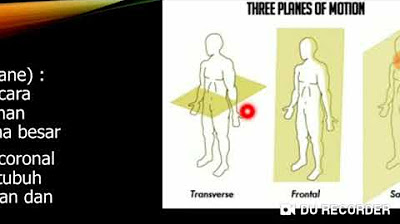Anatomical Position And Directional Terms - Anatomical Terms - Directional Terms Anatomy
Summary
TLDRThe video script introduces anatomical directional terms used to standardize the language of anatomy, reducing confusion when discussing body parts. Key terms include 'superior' and 'inferior' for head-to-foot orientation, 'anterior' and 'posterior' for front-to-back positioning, and 'proximal' and 'distal' for near-to-far locations from the body's axial structure. It also covers 'medial' and 'lateral' for midline-to-side directions, and 'superficial' and 'deep' for surface-to-core depth, all contextualized within the anatomical position for clarity.
Takeaways
- 🧍 The anatomical position is a standard reference for anatomical terms, with the person standing erect, arms at sides, palms forward, and feet forward.
- ⬆️ Superior indicates a direction toward the head or upper part of the body, while ⬇️ inferior points toward the feet or lower part.
- 🔼 Anterior refers to the front of the body, and 🔽 posterior is used for the back.
- 🐢 Ventral is synonymous with anterior, and 🦎 dorsal with posterior, offering alternative terms for the front and back.
- 🔄 Medial is used to describe a direction towards the body's midline, and 🔃 lateral indicates a direction away from the midline towards the side.
- 🦿 Proximal is used for body parts closer to the trunk, while 🦶 distal refers to parts further from the trunk, typically used for the limbs.
- 🏋️♂️ Superficial indicates structures closer to the body's surface, and 🏌️♀️ deep is for structures further from the surface.
- 👀 The terms anterior, posterior, lateral, and proximal/distal can also describe the viewer's perspective when looking at the body.
- 🌐 The midline is an imaginary line dividing the body into left and right halves, important for understanding medial and lateral positions.
- 📚 These directional terms are crucial for clear communication in the field of anatomy to avoid confusion when discussing body parts and their locations.
Q & A
What is the purpose of anatomical directional terms?
-Anatomical directional terms are used to minimize confusion when discussing areas or specific points on the body, ensuring clear communication in reference to the anatomical position.
What is the anatomical position?
-The anatomical position is a standard reference position where a person stands erect with the face forward, arms at the sides, palms facing forward, and feet also pointing forward.
What does the term 'superior' indicate in anatomy?
-Superior indicates a direction towards the head or upper part of the body, such as the heart being superior to the small intestine.
What does 'inferior' mean in the context of anatomical terms?
-Inferior refers to a direction towards the feet or lower part of the body, such as the small intestine being inferior to the heart.
What is the difference between the terms 'anterior' and 'posterior'?
-Anterior means further to the front or in front of, while posterior means further to the back or behind, like the sternum being anterior to the heart.
Can 'ventral' and 'dorsal' be used interchangeably with 'anterior' and 'posterior'?
-Yes, 'ventral' can be used in place of 'anterior' and 'dorsal' in place of 'posterior', both referring to the front and back of the body respectively.
What is the meaning of 'medial' and 'lateral' in anatomical terms?
-Medial refers to a direction towards the midline of the body, while lateral refers to a direction towards the side or away from the midline, such as the heart lying medial to the lungs.
How are the terms 'proximal' and 'distal' used in anatomy?
-Proximal indicates a direction closer to the axial body or trunk, and distal indicates a direction further from the axial body or trunk, like the thigh being proximal to the foot.
What does 'superficial' and 'deep' signify in the context of the body's surface?
-Superficial means closer to the surface of the body, and deep means further away from the surface, such as the sternum being superficial to the lungs.
Why are the terms 'proximal' and 'distal' typically used for the appendicular body?
-'Proximal' and 'distal' are used for the appendicular body, which includes the limbs and appendages, to describe their relative positions to the trunk or axial body.
How can the terms 'anterior' and 'posterior' be used to describe views of the body?
-Anterior and posterior can describe how the body is viewed, such as an anterior view being from the front and a posterior view being from the back.
Outlines

Cette section est réservée aux utilisateurs payants. Améliorez votre compte pour accéder à cette section.
Améliorer maintenantMindmap

Cette section est réservée aux utilisateurs payants. Améliorez votre compte pour accéder à cette section.
Améliorer maintenantKeywords

Cette section est réservée aux utilisateurs payants. Améliorez votre compte pour accéder à cette section.
Améliorer maintenantHighlights

Cette section est réservée aux utilisateurs payants. Améliorez votre compte pour accéder à cette section.
Améliorer maintenantTranscripts

Cette section est réservée aux utilisateurs payants. Améliorez votre compte pour accéder à cette section.
Améliorer maintenantVoir Plus de Vidéos Connexes

Anatomical position

Anatomical Terms: Directional Terms (Anatomy)

A&P I Lab | Exercise 1: Anatomical Position, Directional Terms, & Body Planes

ANATOMI GERAK MANUSIA (BAG. 1) : ISTILAH ARAH, BIDANG ANATOMIS DAN SUMBU ANATOMIS.

Introduction Of Anatomy Sesi 2 - Putri Halleyana Adrikni Rahman, dr., M.Kes

A&P I: chapter 1 orientation
5.0 / 5 (0 votes)
